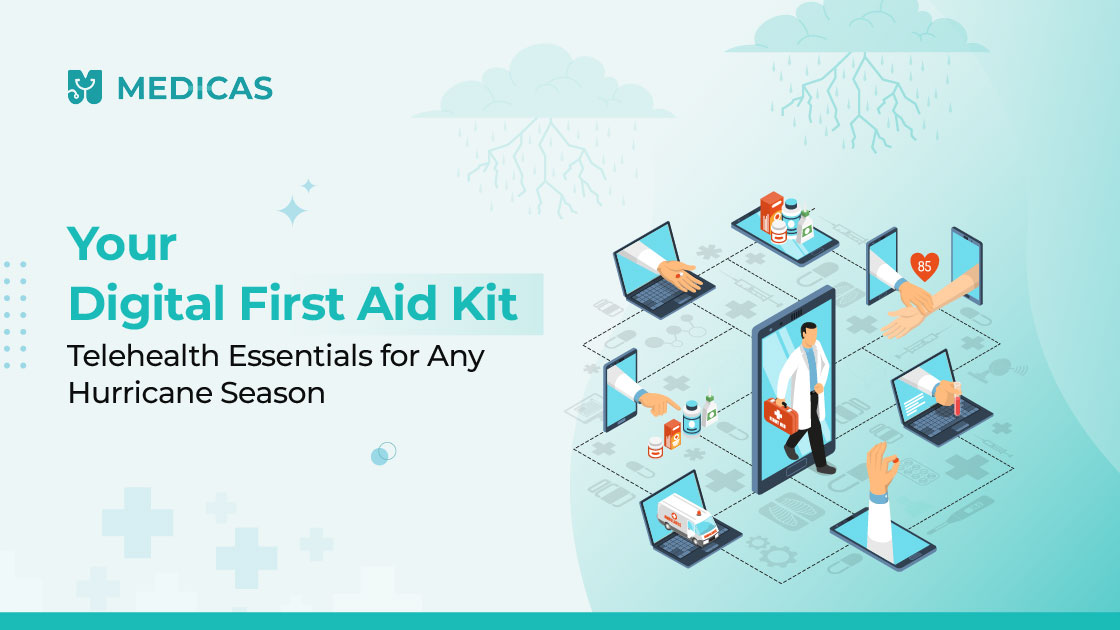- People with chronic conditions like diabetes or asthma
- Pregnant women or new mothers
- Children and the elderly
- Individuals facing acute injuries or infections
Basic Telehealth Essentials for Home
To set up a reliable telehealth kit for hurricane preparedness, include the following:- Smartphone or tablet with video capability
- Fully charged power bank or solar-powered charger
- Mobile data plan or offline consultation apps
- A list of important medical records and prescriptions stored digitally
- Downloaded telehealth apps like Medicas for online doctor consultations
Emergency-Specific Tools for Hurricane Season
For added resilience:- Pulse oximeter and thermometer
- First-aid supplies (bandages, antiseptics, OTC meds)
- Digital blood pressure monitor or glucometer (if needed)
- Access to mental health professionals
- Bookmarked resources for home remedies and self-care
- Provide 24/7 access to licensed physicians
- Allow prescription renewals
- Include mental health support
- Enable lab test bookings (even post-disaster) like Medicas Lab Tests
- Download your preferred telehealth apps and test them.
- Save emergency contacts within the app.
- Charge all digital devices fully and keep chargers in one place.
- Write down essential health information (allergies, medications, conditions).
- Book an appointment for a pre-storm check-in if you’re in a high-risk group.
- Use mobile networks (3G/4G) to access telehealth apps
- Turn on low-power mode to preserve battery
- Use downloaded offline content and guides
- A diabetic man in Dominica was able to get insulin dosage adjustments via video consultation after his local pharmacy flooded.
- A pregnant woman in Tobago used emergency telehealth to get help managing contractions until she could be evacuated.
- Families in Puerto Rico accessed pediatric care via mobile during extended outages.
Frequently Asked Questions (FAQs)
- What is a digital first aid kit?
- Why is telehealth important during a hurricane?
- Do telehealth services work during power outages or no internet?
- Can I get prescriptions via telehealth in a hurricane emergency?
- How do I prepare my telehealth setup before a hurricane hits?
Disclaimer
Medical Advice: The information provided in this blog post is for educational purposes only and should not be considered as a substitute for professional medical advice, diagnosis, or treatment. Always consult with a qualified healthcare professional for personalized guidance regarding your specific medical condition.
Accuracy of Information: While we strive to provide accurate and up-to-date information, the field of medicine and viral fevers is constantly evolving. The content in this blog post may not reflect the most current research or medical guidelines. Therefore, it is advisable to cross-check any information provided with reliable sources or consult a healthcare professional.
Individual Variations: The symptoms, causes, treatment options, and preventive measures discussed in this blog post are general in nature and may not apply to everyone. It is important to remember that each individual’s situation is unique, and personalized medical advice should be sought when making healthcare decisions.
External Links: This blog post may contain links to external websites or resources for additional information. However, we do not endorse or have control over the content of these third-party websites. Accessing these links is done at your own risk, and we are not responsible for any consequences or damages that may arise from visiting these external sources.
Results May Vary: The effectiveness of treatment options or preventive measures mentioned in this blog post may vary from person to person. What works for one individual may not work the same way for another. It is essential to consult with a healthcare professional for personalized advice tailored to your specific needs.

Mr. Leroy Lewis is a holistic psychologist with over 14 years of experience in counselling and mental health care. Based in Chaguanas, Trinidad and Tobago, he is committed to helping individuals overcome emotional challenges and achieve personal growth. With a Master’s in Counselling Psychology and extensive training in trauma, addiction, and employee assistance programs, he blends clinical insight with a compassionate, client-centred approach.


